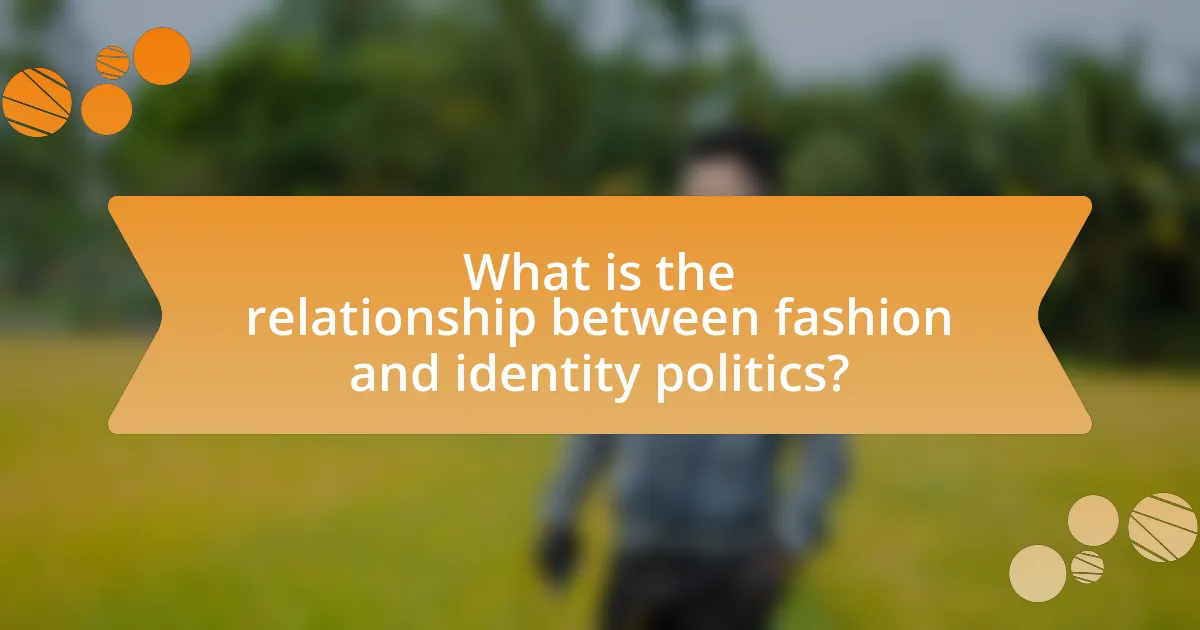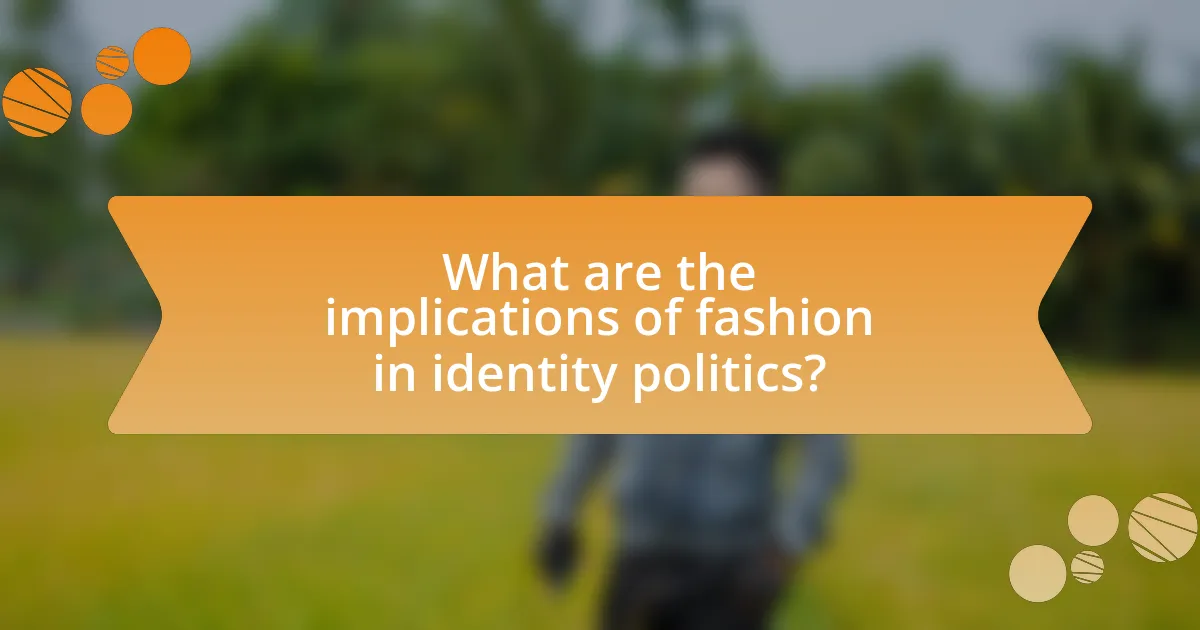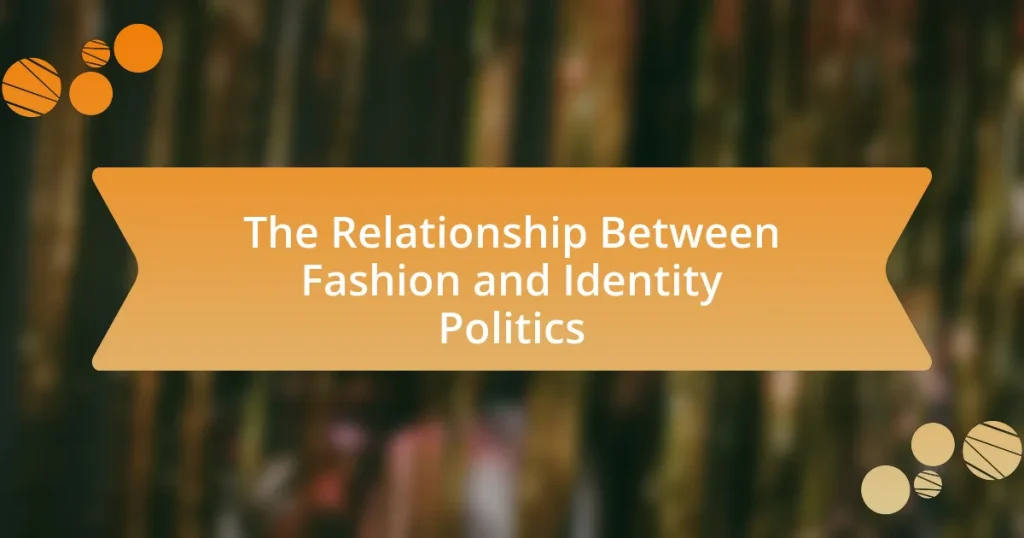The article examines the intricate relationship between fashion and identity politics, highlighting how fashion serves as a medium for individuals to express their identities related to race, gender, sexuality, and socio-economic status. It discusses the role of fashion in personal and collective identity formation, cultural expression, and the impact of social movements on fashion trends. Additionally, the article addresses the challenges faced by designers of color, the influence of LGBTQ+ communities on fashion, and the significance of representation in fashion marketing. It concludes by exploring future trends in fashion and identity politics, emphasizing sustainability and technology’s role in shaping these dynamics.

What is the relationship between fashion and identity politics?
Fashion and identity politics are interconnected as fashion serves as a medium for individuals to express their identities, including race, gender, sexuality, and socio-economic status. This relationship is evident in how marginalized groups utilize fashion to challenge societal norms and assert their identities, often leading to broader cultural conversations about representation and inclusivity. For instance, the rise of streetwear has been linked to the empowerment of urban youth and communities of color, reflecting their cultural narratives and resistance against mainstream fashion standards. Additionally, events like the Black Lives Matter movement have seen fashion become a tool for activism, where clothing choices symbolize solidarity and identity. Thus, fashion not only reflects identity politics but actively participates in shaping and redefining them.
How does fashion influence personal and collective identity?
Fashion significantly influences personal and collective identity by serving as a medium for self-expression and social categorization. Individuals use fashion choices to convey their beliefs, values, and social affiliations, which helps shape their personal identity. For example, research by sociologist Thorstein Veblen highlights how clothing can signify social status and group membership, reinforcing collective identity among specific communities. Additionally, fashion trends often reflect cultural movements, such as the punk movement of the 1970s, which used style as a form of rebellion and collective identity formation. Thus, fashion acts as both a personal statement and a collective symbol, impacting how individuals and groups perceive themselves and are perceived by others.
What role does fashion play in expressing cultural identity?
Fashion serves as a significant medium for expressing cultural identity by allowing individuals to showcase their heritage, beliefs, and values through clothing choices. This expression is evident in traditional garments, which often reflect historical narratives and cultural symbols unique to specific communities. For instance, the use of indigenous patterns and textiles in fashion not only preserves cultural heritage but also promotes awareness and appreciation of that culture. Studies have shown that clothing can influence perceptions of identity, with research indicating that 70% of individuals feel their attire reflects their cultural background. Thus, fashion acts as a visual language that communicates cultural identity, fostering a sense of belonging and community among individuals.
How does fashion contribute to the formation of gender identity?
Fashion significantly contributes to the formation of gender identity by providing individuals with a means to express and communicate their gender through clothing choices. Clothing styles, colors, and accessories often carry cultural and societal meanings that align with traditional gender norms, influencing how individuals perceive themselves and how they are perceived by others. For instance, research indicates that the adoption of specific fashion trends can reinforce or challenge gender stereotypes, as seen in the rise of gender-neutral clothing lines that promote inclusivity and fluidity in gender expression. This dynamic interplay between fashion and gender identity is evident in historical movements, such as the women’s liberation movement of the 1960s, where clothing became a symbol of empowerment and resistance against traditional gender roles. Thus, fashion serves as both a reflection and a shaping force in the ongoing discourse surrounding gender identity.
Why is identity politics significant in the fashion industry?
Identity politics is significant in the fashion industry because it shapes consumer identity and influences brand representation. The fashion industry often reflects and responds to societal issues related to race, gender, sexuality, and class, making it a platform for marginalized voices. For instance, brands like Savage X Fenty and Aerie have gained recognition for promoting body positivity and inclusivity, which resonate with diverse consumer demographics. This shift not only drives sales but also fosters brand loyalty among consumers who prioritize social justice and representation in their purchasing decisions.
How do social movements shape fashion trends?
Social movements shape fashion trends by influencing cultural values and societal norms, leading to the adoption of specific styles that reflect the movement’s ideals. For instance, the feminist movement of the 1960s and 1970s popularized clothing that symbolized women’s liberation, such as pants and more practical attire, challenging traditional gender norms. Similarly, the LGBTQ+ rights movement has led to the embrace of vibrant colors and non-binary fashion, promoting inclusivity and self-expression. These shifts in fashion are often documented in studies, such as “Fashion and Social Movements” by Elizabeth Wissinger, which highlights how clothing choices serve as a form of activism and identity representation.
What impact does representation have on fashion marketing?
Representation significantly impacts fashion marketing by influencing consumer perception and brand loyalty. When fashion brands showcase diverse models and inclusive imagery, they resonate more deeply with a broader audience, fostering a sense of belonging and relatability. Research indicates that 67% of consumers consider a brand’s commitment to diversity when making purchasing decisions, highlighting the importance of representation in driving sales and enhancing brand reputation. Furthermore, brands that prioritize representation often see increased engagement on social media platforms, as consumers are more likely to share and support brands that reflect their identities and values.

How do different identities interact with fashion?
Different identities interact with fashion by using clothing and style as a means of self-expression and social signaling. Individuals from various cultural, gender, and socioeconomic backgrounds often adopt fashion choices that reflect their personal identities, beliefs, and affiliations. For instance, research shows that LGBTQ+ individuals may use fashion to challenge traditional gender norms and assert their identities, while marginalized communities often utilize fashion to reclaim cultural heritage and resist mainstream narratives. This interaction is evident in movements like Black Fashion, which emphasizes the significance of African American contributions to fashion and seeks to address issues of representation and equity within the industry.
What are the intersections of race and fashion?
The intersections of race and fashion manifest in how cultural identity, representation, and social dynamics influence clothing choices and trends. Fashion often reflects and shapes societal attitudes towards race, as seen in the appropriation of cultural garments by dominant groups, which can lead to controversy and discussions about authenticity and respect. For instance, the use of traditional African prints in mainstream fashion raises questions about cultural appreciation versus appropriation, highlighting the need for acknowledgment of the origins and significance of these designs. Additionally, the fashion industry has historically marginalized designers and models of color, impacting visibility and opportunities within the field. This dynamic illustrates how race informs not only personal expression through fashion but also broader industry practices and consumer perceptions.
How does fashion reflect racial identity and experiences?
Fashion reflects racial identity and experiences by serving as a medium through which individuals express their cultural heritage and social narratives. For instance, traditional garments like the African dashiki or the Indian sari not only signify cultural pride but also communicate the wearer’s racial background and personal history. Additionally, fashion trends often emerge from specific racial communities, influencing mainstream culture while simultaneously highlighting issues of representation and appropriation. Historical events, such as the Civil Rights Movement, saw fashion become a tool for activism, where clothing choices symbolized resistance and solidarity among marginalized groups. This interplay between fashion and racial identity underscores how attire can encapsulate complex social dynamics and personal experiences tied to race.
What challenges do designers of color face in the fashion industry?
Designers of color face significant challenges in the fashion industry, including systemic racism, lack of access to funding, and limited representation in decision-making roles. Systemic racism manifests in biased hiring practices and unequal opportunities for visibility and promotion, which restricts the growth of their brands. Additionally, a 2020 study by the Council of Fashion Designers of America found that only 5% of fashion designers are Black, highlighting the stark underrepresentation in the industry. Furthermore, designers of color often struggle to secure funding, as venture capital firms tend to favor established brands, which disproportionately affects minority-owned businesses. These barriers contribute to a cycle of exclusion that hinders the success and recognition of designers of color in the fashion landscape.
How does gender identity manifest in fashion choices?
Gender identity manifests in fashion choices through the selection of clothing, accessories, and styles that align with an individual’s self-perception and societal roles. For instance, individuals who identify as non-binary may choose androgynous clothing that defies traditional gender norms, while those identifying as transgender often select garments that affirm their gender identity, such as women adopting dresses or men opting for tailored suits. Research indicates that fashion serves as a medium for expressing gender identity, with studies showing that 70% of LGBTQ+ individuals report using fashion to communicate their identity to the world. This demonstrates that fashion is not merely about aesthetics but is deeply intertwined with personal and social identity politics.
What are the implications of gender fluidity in fashion design?
Gender fluidity in fashion design challenges traditional gender norms, allowing for a more inclusive and diverse representation of identity. This shift encourages designers to create garments that are not confined to binary classifications, thus broadening the market appeal and fostering creativity. For instance, brands like Gucci and Telfar have embraced gender-neutral collections, reflecting societal changes and consumer demand for non-binary options. The implications extend to marketing strategies, where inclusive campaigns resonate with a wider audience, ultimately influencing purchasing behavior and brand loyalty.
How do LGBTQ+ communities influence fashion trends?
LGBTQ+ communities significantly influence fashion trends by promoting diversity, challenging traditional gender norms, and fostering creativity. This influence is evident in the rise of gender-fluid clothing lines and the mainstream acceptance of styles that blend masculine and feminine elements. For instance, designers like Jean-Paul Gaultier and brands such as Comme des Garçons have drawn inspiration from LGBTQ+ culture, leading to innovative fashion that reflects broader societal changes. Additionally, events like Pride parades showcase vibrant, expressive styles that often set trends adopted by the wider fashion industry, demonstrating the community’s role in shaping contemporary aesthetics.

What are the implications of fashion in identity politics?
Fashion plays a significant role in identity politics by serving as a medium through which individuals express their social, cultural, and political identities. The implications of this relationship are profound, as fashion can reinforce or challenge societal norms and power dynamics. For instance, marginalized groups often use fashion to assert their identity and resist dominant cultural narratives, as seen in movements like the Black Panther Party, which utilized specific styles to convey political messages and solidarity. Additionally, fashion can perpetuate stereotypes or create inclusivity, influencing public perception and social discourse. The visibility of diverse representations in fashion can empower individuals and foster a sense of belonging, while also prompting critical conversations about race, gender, and class.
How does fashion serve as a tool for activism?
Fashion serves as a tool for activism by enabling individuals and groups to express social and political messages through their clothing choices. This form of expression can raise awareness about issues such as gender equality, climate change, and racial justice. For instance, the “Black Lives Matter” movement has utilized fashion by promoting apparel that features its logo, thereby fostering solidarity and visibility for the cause. Additionally, designers like Stella McCartney advocate for sustainable fashion, highlighting environmental concerns through their collections. The impact of fashion as activism is further evidenced by the rise of campaigns like “Fashion Revolution,” which calls for transparency in the fashion industry, urging consumers to consider the ethical implications of their purchases.
What are examples of fashion campaigns that promote social change?
Examples of fashion campaigns that promote social change include the “Fashion for Freedom” initiative by the brand Reformation, which advocates for sustainable practices and ethical labor in the fashion industry. Another notable campaign is the “This is What a Feminist Looks Like” t-shirt line by the brand FCKH8, which raises awareness and funds for feminist causes. Additionally, the “We Are All Human” campaign by the brand H&M promotes inclusivity and diversity, highlighting the importance of representation in fashion. These campaigns effectively leverage fashion to address social issues, demonstrating the industry’s potential to influence public discourse and drive change.
How can fashion be used to challenge societal norms?
Fashion can be used to challenge societal norms by serving as a medium for self-expression and activism. Designers and individuals often create garments that defy traditional gender roles, promote body positivity, or highlight social issues, thereby questioning established standards. For instance, the rise of gender-neutral clothing lines and the use of fashion in movements like Black Lives Matter illustrate how clothing can convey messages of resistance and inclusivity. Historical examples include the punk movement of the 1970s, where fashion was deliberately provocative to challenge mainstream culture. Such instances demonstrate that fashion not only reflects societal values but can actively reshape them by encouraging dialogue and promoting alternative identities.
What are the future trends in fashion and identity politics?
Future trends in fashion and identity politics will increasingly emphasize inclusivity and representation. As society becomes more aware of diverse identities, fashion brands are likely to adopt more inclusive sizing, gender-neutral clothing, and culturally diverse designs. For instance, the rise of brands like Savage X Fenty showcases a commitment to body positivity and inclusivity, reflecting a broader societal shift towards acceptance of various identities. Additionally, the integration of technology, such as virtual fitting rooms and augmented reality, will allow consumers to engage with fashion in ways that celebrate individual identity. This trend is supported by research indicating that consumers are more likely to support brands that align with their values regarding diversity and representation.
How is technology shaping the relationship between fashion and identity?
Technology is shaping the relationship between fashion and identity by enabling personalized expression and democratizing access to fashion trends. Digital platforms allow individuals to curate their identities through social media, where fashion choices are shared and validated by online communities. For instance, the rise of influencers and fashion bloggers has shifted traditional fashion authority, allowing diverse identities to be represented and celebrated. Additionally, advancements in virtual reality and augmented reality provide immersive experiences for consumers, allowing them to visualize how clothing fits their personal style before purchase. This technological integration not only enhances individual expression but also fosters a sense of belonging within various identity groups, as seen in the popularity of niche fashion subcultures online.
What role will sustainability play in future identity politics within fashion?
Sustainability will play a crucial role in future identity politics within fashion by shaping consumer values and brand identities. As awareness of environmental issues increases, consumers are increasingly aligning their identities with sustainable practices, leading brands to adopt eco-friendly materials and ethical production methods. For instance, a 2021 survey by McKinsey found that 67% of consumers consider sustainability when making fashion purchases, indicating a significant shift in consumer behavior that brands must respond to in order to remain relevant. This alignment of sustainability with identity politics will drive brands to not only market their products as environmentally friendly but also to engage in broader social issues, thereby influencing their brand narratives and consumer loyalty.
What practical steps can individuals take to engage with fashion and identity politics?
Individuals can engage with fashion and identity politics by consciously selecting clothing that reflects their values and identities. This involves researching brands that prioritize ethical practices, inclusivity, and representation, thereby supporting those that align with personal beliefs. For instance, studies show that consumers increasingly prefer brands that advocate for social justice, with 66% of global consumers willing to pay more for sustainable brands (Nielsen, 2015). Additionally, individuals can participate in discussions and movements that challenge traditional fashion norms, such as advocating for body positivity and diversity in fashion campaigns. By sharing personal stories and experiences related to identity through social media platforms, individuals can amplify marginalized voices and foster community engagement.



